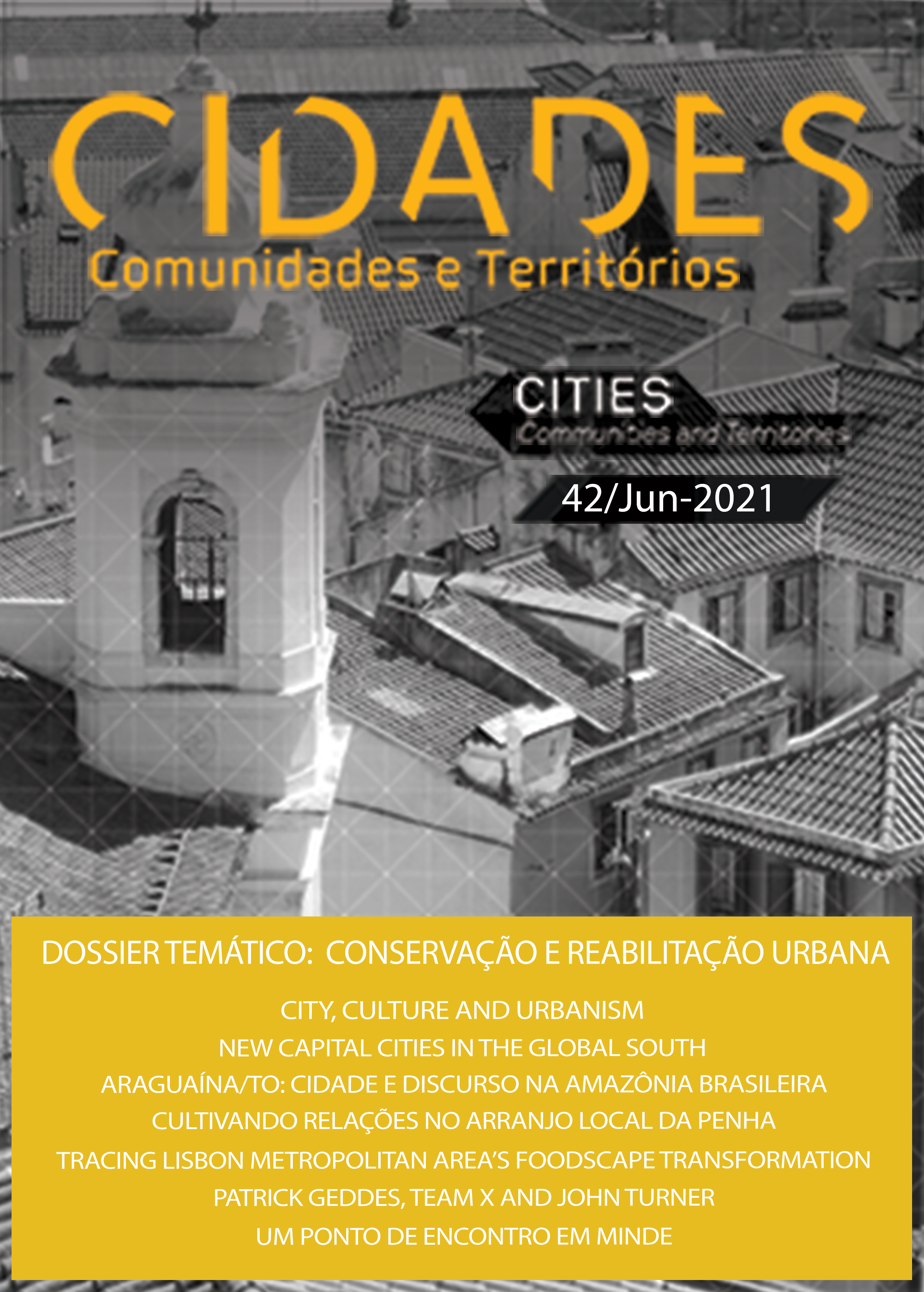Intervir em espaços de valor patrimonial e paisagístico
Projetar e construir em Minde, Portugal
Mots-clés :
paisagem, património, arquitetura, ensino de arquitetura, MindeRésumé
O presente artigo explora a aproximação do ensino da arquitetura à relação entre o património edificado e paisagístico das comunidades através de projetos que intervêm diretamente no território, criando soluções construtivas e materiais que estabelecem pontos de diálogo com a identidade dos lugares. O artigo incide em particular na conceção e materialização de um projeto de caráter temporário para o Festival Materiais Diversos, que teve lugar em Minde, em setembro de 2019. A escolha dos materiais, das soluções construtivas e da própria execução em obra refletem de um modo evidente a relação com o património cultural e natural desta região. Por outro lado, a flexibilidade do sistema e a sua capacidade de reutilização permitem que este diálogo ganhe novos significados na sua relação com o território. O artigo pretende contribuir para o debate sobre a importância de explorar a relação entre o território e o património local aquando da construção de estruturas destinadas a eventos temporários, de forma a obter resultados que, quer do ponto de vista dos materiais, quer da sua forma e função, contribuam para dinâmicas locais de valorização territorial.
Références
AA.VV. (1988). Arquitectura Popular Portuguesa. 3ª ed. Lisboa: AAP.
Abreu, A. C. d’, Correia, T. P., Oliveira, R. (2004). Contributos para a Caracterização e Identificação da Paisagem em Portugal Continental, v. I e IV. Lisboa: Direcção-Geral do Ordenamento do Território e Desenvolvimento Urbano.
Carvalho, R., Marques, T. (2019). A evolução do conceito de paisagem cultural, Revista de Geografia e Ordenamento do Território (GOT), 16. Lisboa: Centro de Estudos de Geografia e Ordenamento do Território, 81–98.
Choay, F. (2000). A alegoria do património. Lisboa: Presença.
Cosgrove, D. (1988). The Geometry of Landscape: Practical and Speculative Arts in Sixteenth-Century Venetian Land Territories. In S. Daniels, & D. Cosgrove (orgs.) The Iconography of Landscape: Essays on the Symbolic Representation, Design and Use of Past Environments. Cambridge: Cambridge University Press, 254–276.
Di Méo, G. (1994). Patrimoine et territoire, une parenté conceptuelle, Espaces et Sociétés, 78. Paris: L’Harmattan, 15–34.
Domingues, Á. (2009). A Rua da Estrada. Porto: Dafne Editora.
Domingues, Á. (2017). Volta a Portugal. Lisboa: Contraponto Editores.
Filleron, J.-C. (2008). Paysage, pérennité du sens et diversité des pratiques, Actes Sémiotiques. https://www.unilim.fr/actes-semiotiques/1265
Lopes, F., Correia, M. B. (2004). Património arquitectónico e arqueológico, cartas, recomendações e convenções internacionais. Lisboa: Livros Horizonte.
Oliveira, E. V. de, Galhano, F. (1994). Arquitectura tradicional portuguesa. 2ª ed. Lisboa: Dom Quixote.
Quintela, J., Ramalhete, F. (2020). Aprender enquanto se constrói – intervenções em territórios de proximidade: o caso dos laboratórios in situ/. In P. C. Remoaldo et al., XII Congresso da Geografia Portuguesa, Geografias de Transição para a Sustentabilidade. Livro de Atas. Guimarães: Universidade do Minho, 721–726.
Quintela, J., Ramalhete, F. (2019). Ensinar, investigar, intervir - o caso dos Laboratórios de Intervenção em Arquitetura in situ/, CAP Cadernos de Arte Pública Public Art Journal, 1, 12–21. http://sauc.website/index.php/CAP/issue/view/8
Ramalhete, A. F. R. (2006). Centros históricos e ordenamento do território em áreas metropolitanas. Tese de doutoramento em Engenharia do Ambiente, ramo do Ordenamento do Território apresentada à Universidade Nova de Lisboa. Lisboa: Universidade Nova de Lisboa.
Ramalhete, F., Silva, S., Caldas, J. C., Quintela, J. (2020) In situ/, Laboratórios de Intervenção em Arquitetura 2012-2019. Lisboa: Universidade Autónoma de Lisboa.
Ramalhete, F., Silva, S. (2014). Intervenções arquitetónicas em espaços informais, Estudo Prévio, 5/6, Lisboa: CEACT/UAL - Centro de Estudos de Arquitetura, Cidade e Território da Universidade Autónoma de Lisboa. http://www.estudoprevio.net/artigos/43/filipa-ramalhete-sergio-silva-.-intervencoes-arquitetonicas-em-espacos-informais
Ramalhete, F., Silva, F. (2016). Reabilitação colaborativa: a experiência do Laboratório de Intervenção em Arquitetura INSITU’15. In M. Menezes, & J.D. Rodrigues (eds.). Atas do Congresso Ibero-Americano "Património, suas matérias e imatérias”. Lisboa: LNEC, 115–116.
Ribeiro, O. (1988). Portugal, o Mediterrâneo e o Atlântico. Lisboa: Livraria Sá da Costa, (8ª edição).
Solá, A. G. S., Vilhelmson, B. (2019). Negotiating Proximity in Sustainable Urban Planning: A Swedish Case, Sustainability 2019, 11–31. https://doi.org/10.3390/su11010031
Trigal, L. Lopez (dir.), Fernandes, J. A. R., Sposito, E. S., Figuera, D. T. (coords.) (2015) Diccionario de Geografia Aplicada e Profesional, Terminologia de analisis, planificacion y gestion del território. León: Universidad de León.
Schneider, T., Till, J. (2009). Beyond Discourse: Notes on Spatial Agency, FOOTPRINT Agency in Architecture: Reframing Criticality. Theory and Practice (Janeiro), 97–111. https://journals.open.tudelft.nl/footprint/article/view/702
Telles, G. R. (2011). Textos escolhidos. Lisboa: Argumentum.
Wenger-Trayner, E. and B. (2015) Introduction to communities of practice A brief overview of the concept and its uses. http://wenger-trayner.com/introduction-to-communities-of-practice/
Xavier, S. (2000). O monumento é o vale, retórica da paisagem no Vale do Côa, Etnográfica, IV, 1. 109–128.
Téléchargements
Publié-e
Numéro
Rubrique
Licence
© João Quintela, Filipa Ramalhete 2021

Cette œuvre est sous licence Creative Commons Attribution - Pas d'Utilisation Commerciale - Pas de Modification 4.0 International.
Cidades, Comunidades e Territórios by DINÂMIA'CET-IUL is licensed under a Creative Commons Atribuição-Uso Não-Comercial-Proibição de realização de Obras Derivadas 4.0 Unported License.Permissions beyond the scope of this license may be available at mailto:cidades.dinamiacet@iscte.pt.






